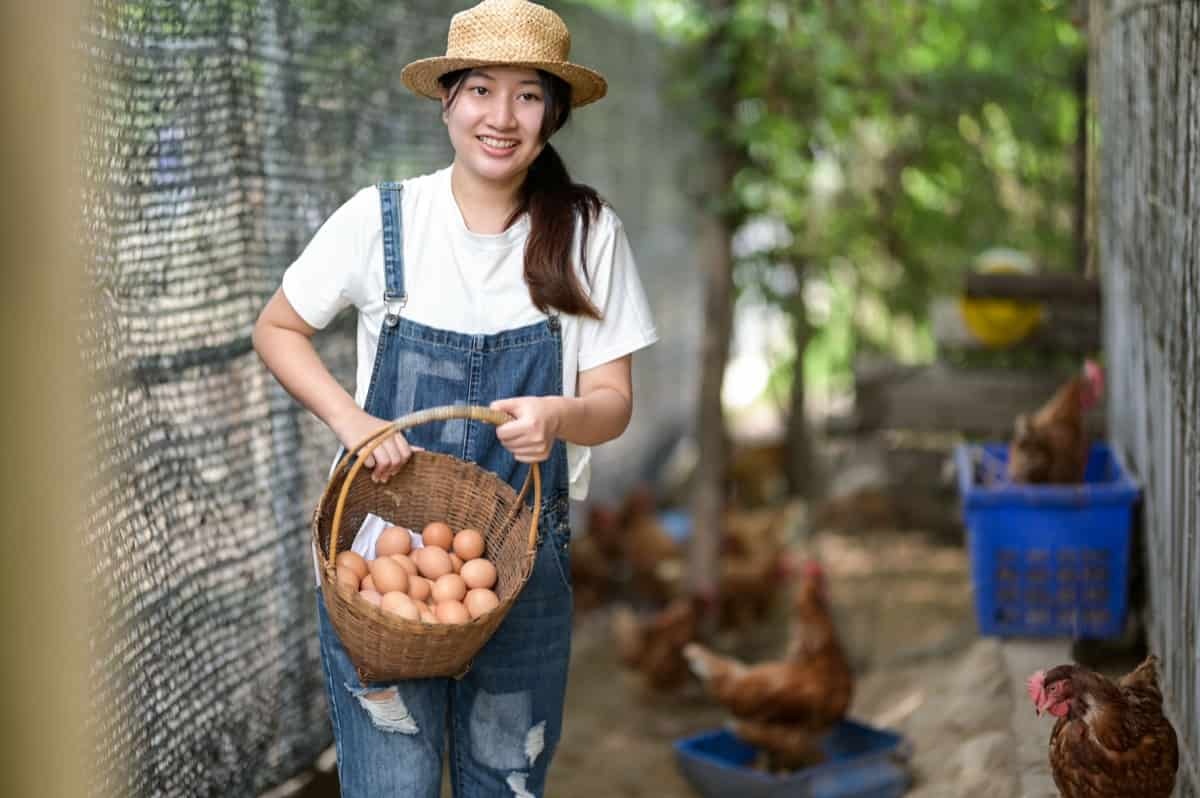Egg quality and size are important considerations in both culinary and agricultural situations. Understanding the elements that determine these characteristics is critical for egg growers, chefs, and consumers. Numerous factors influence eggs’ quality and size, from laying hen food and age to environmental circumstances and breeding procedures. This discussion will thoroughly investigate these elements to understand what influences egg quality and size.

What Affects the Quality and Size of the Chicken Eggs
Genetics and Breed of the Hen
The breed significantly impacts the size of eggs that hens produce. Due to intrinsic body size limits, smaller chicken breeds often lay smaller eggs. Larger chicken breeds, on the other hand, are more likely to lay medium to big eggs. Individual hens may vary in egg size even within the same breed, as hereditary variables can impact egg size.
Geneticists have made tremendous progress in producing commercial lines of hens with varying egg size ranges. They accomplished this through selective breeding because egg weight is a heritable feature that responds well to genetic selection. This means that carefully selecting breeding stock makes it feasible to stimulate egg production within a specific size range.Non-genetic variables account for approximately 60% of the variation in egg size. Nutrition and managerial methods are examples of such influences. Providing laying hens with a well-balanced feed rich in nutrients is critical for achieving optimal egg size.
Age of the Hen
The age of a hen is an important factor in determining egg size. Younger hens often lay smaller eggs, which increase in size as they mature. When hens reach roughly one year of age, the peak in egg size can be expected. However, when chickens near the conclusion of their laying cycle, which varies depending on breed and individual characteristics, egg size tends to decline once more.
In case you missed it: Why Are Your Chickens Laying Soft Eggs: Find Out the Causes

The normal progression of egg size in a hen’s life is tied to her reproductive cycle. Hens’ reproductive systems become more efficient as they mature, resulting in larger eggs. Egg production decreases as they approach the conclusion of their laying season, resulting in smaller eggs. Understanding age-related patterns in egg size is therefore critical for poultry keepers and producers to successfully manage their flocks and predict variations in egg size throughout time.
Nutrition and Diet
Proper nutrition during the raising stage enables the hen to meet or exceed standard body weights. Diet parameters can be utilized to influence egg size during the laying season. Energy, methionine/cystine, other digestible amino acids, linoleic acid, and total fat can all directly affect egg size and, when fed correctly, can result in larger eggs. If mineral requirements are not met, and birds lay too many eggs, the shells of the eggs will be thinner and more cracked.
Protein is a vital dietary component that must also be well-balanced. Because eggs are a high protein source, birds require sufficient protein in their diet. If all necessary nutrients are present in adequate quantities in the feed, the higher the feed consumption, the larger the eggs. Any factor, such as crowding or stress that prevents feed consumption will reduce egg size. Environmental temperatures above a bird’s thermoneutral zone (>33 degrees Celsius) reduce feed intake.
Health and Well-being of the Hen
The hen’s overall health and well-being are critical. Sick or anxious hens are more likely to lay inferior eggs. Maintaining egg quality requires proper wellness and stress management. Overcrowding, noisy settings, and disturbances in the coop can all contribute to poor quality. A stress-free atmosphere encourages better egg production.
Environmental Factors
Temperature: The temperature of a house has a significant impact on the size of eggs produced. In warmer weather, eggs are frequently tiny. Feed consumption decreases when the temperature is too high, and hens lay fewer eggs. When the temperature in the house rises above 27 degrees Celsius (80 degrees Fahrenheit), the eggs become smaller.
Lighting: Chickens react to changes in day length. During the growth stage, illumination programs affect egg size. Lighting patterns can either delay or hasten the sexual maturation of poultry. The age at which a chicken begins laying substantially impacts egg size. The flock’s body weight and homogeneity should determine the intensity of light stimulation. Later, light stimulation and higher body weights will cause maturity to be delayed and egg size to increase.
Laying Cycle
The laying cycle of hens substantially impacts egg quality and size. Eggs produced early in the cycle are generally smaller and have thinner shells. Egg size and shell quality improve as the cycle advances. Excessive laying without appropriate rest, on the other hand, can result in smaller and lower-quality eggs. Maintaining egg size and quality throughout the laying cycle requires proper diet, ambient conditions, and rest intervals.
In case you missed it: American Buff Goose: Origin, Characteristics, Lifespan, Price, Egg Production, Size, Pros, and Cons

Egg Handling and Storage
Maintaining egg quality and size requires proper egg handling and storage. To avoid contamination, eggs should be collected quickly and stored with the pointy end down to protect the air cell. Refrigeration around 35-40°F (1.7-4.4°C) is required to reduce moisture loss and bacterial growth. Improper handling and storage can diminish egg quality, affecting taste, texture, and size due to moisture loss or decomposition.
Stress Levels
High amounts of stress can have a detrimental impact on the quality and size of eggs in females. Chronic stress can cause hormonal imbalances, resulting in irregular ovulation and poor egg quality. Cortisol release caused by stress may also impact blood flow to the ovaries, limiting food availability to growing eggs. As a result, smaller, less viable eggs may be produced, affecting fertility and reproductive success.
Disease and Parasite Control
Effective disease and parasite control plays a crucial role in maintaining the quality and size of eggs in poultry farming. Disease outbreaks and parasitic infestations can stress birds, reducing egg production and smaller egg sizes. Controlling these threats through proper management practices, vaccination, and parasite prevention ensures healthier hens, optimal egg development, and larger, higher-quality eggs, ultimately enhancing productivity and profitability in the poultry industry.
Hormonal Factors
Hormonal considerations significantly impact the quality and size of eggs in females. Follicle-stimulating hormone (FSH) and luteinizing hormone (LH) influence egg formation by regulating ovarian function. A healthy hormonal balance ensures the generation of high-quality, mature eggs required for fertility. Hormonal imbalances can result in inadequate egg quality and size, influencing fertility and reproductive consequences.
In case you missed it: Embden Goose Breed: Physical Characteristics, Egg Production, Breeding, and Feed Requirement

Conclusion
A complex combination of genetic, environmental, dietary, and hormonal factors influences egg quality and size. Age, diet, health, environmental conditions, the laying cycle, egg handling, stress levels, illness control, and hormonal balance all play important roles in influencing egg quality and size. Understanding and regulating these variables is critical for egg producers and consumers to maintain consistent egg quality and size.
- Feed Your Flock for Less: Top 10 Tips to Save on Chicken Feed
- Ultimate Guide to Ossabaw Island Hog: Breeding, Raising, Diet, and Care
- Hatching Answers: The Top 10 Reasons Your Chickens Aren’t Laying Eggs
- Eggs and Economics: Breaking Down the Cost of Raising Backyard Chickens
- Defend Your Greens: Proven Methods to Keep Iguanas Out of Your Garden
- Ultimate Guide to Cinnamon Queen Chicken: A Comprehensive Guide for Beginners
- Ultimate Guide to California Tan Chicken: Breeding, Raising, Diet, Egg-Production and Care
- Ultimate Guide to Marsh Daisy Chicken: Breeding, Raising, Diet, and Care
- 10 Types of Chicken Farming Businesses You Can Start for Profits